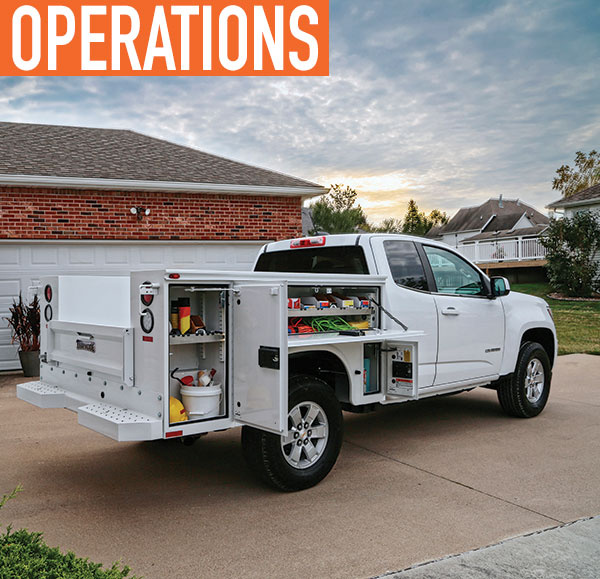Picture this: You roll up to a jobsite, hop out of your truck, and slam your jug of coffee down on the roof of your service body just as the sun peeks over the horizon. You walk around the truck (mulling where you left your tool belt along the way), pop open one of your compartments, and out comes everything—including the new guy’s lunch from yesterday.
Now you get to spend the first 30 minutes of your workday rooting through a hodgepodge of items on the ground and decide where you’re going to stuff them, just to start the day. How does that sound for productivity? Not good.
Many of you likely don’t fall into the category of mass service body mayhem. But, that doesn’t mean it’s not important to consider the benefits of keeping an organized work space, including:
- Staying on schedule—not just from job to job in a single day, but also over the course of a longer project
- Minimizing headaches and frustration, which can distract your focus and affect your efficiency
- Making a good impression on your customers; you want to appear professional and trustworthy
COMPARTMENTALIZE
Simply owning a service body allows one to take advantage of the inherent storage advantages that come with it. Rather than just tossing things in the back of a pickup or van, a service body offers high-level compartmental organization to help you organize the stuff you need to get the job done.
The way you do it is up to you, but it’s important to have a plan of attack when stocking your service body compartments. Here are a few basic things to keep in mind:
- Many people prefer to keep their most-used items (such as tool belts and essential tools) in the compartment directly behind the driver’s door, where they’re easily accessible.
- Small hardware items oftentimes make sense on the curb-side of a service body. Some of these items can be hard to find, so rooting around compartment shelves on the street-side of the vehicle is never a good idea. Organization of these items is paramount.
- Personal preferences matter. It’s ok to keep tools compartmentalized in a way that makes the most sense to you. Maybe you want to group them by type. Maybe you like to group them by job function. Whatever you choose, make sure they’re in a place that makes sense to your vocation and current job.
GO BIG (BY SORTING SMALL)
While compartments are a great option for keeping large items separated and safe, even more finite storage solutions are often needed across all vocations. Storage solutions have become increasingly popular in recent years in both the van and service body industries, and they’re an extremely viable option to clean up the inside of your body.
Keeping tools, hardware, and other items in inner-compartment storage bins and boxes gives a neat appearance and makes things even easier to find.
Other internal storage tips:
- Find a method that works for your small items. Make sure they all have a dedicated place in the vehicle. The smallest items often rack up the largest amounts of wasted time.
- In lieu of inner-compartment storage solutions, additional shelves can help add storage real estate inside compartments.
- Don’t mistake vertical space for storage space. Filling it can be a double-edged sword, as stacking can create a cluttered, inefficient space. This is where additional shelving and storage solutions come in.
KEEP A CLEAN ROUTINE
Your parents may have told you, “Put it back where you found it!” Your service body should be no different. One of the easiest ways to maintain an organized service body is to consciously focus on returning things to their respective place when you’re done with them. Keeping an organization routine at the start and end of each day is a great way to ensure you spend minimal time on the clock searching for the tools you need.
If you just can’t gather the time before or after your day, it’s important to schedule regular TLC time for your service body, including organization needs. Whether it’s weekly, monthly, or beyond, time spent organizing your vehicle can exponentially increase time on the job.
THE RIGHT IMPRESSION
Keeping an eye on service body organization can do a lot of things, but none may be more important than the way your business is presented to customers. We’ve talked about the money you may be losing through inefficiency in the field, but don’t forget the business that you could also be losing on the front end.
Let’s imagine someone pulls up to bid a project on your house. You immediately notice they have a haphazardly organized truck. Ladders are half fastened down, compartments are overflowing, and the vehicle is an overall mess. This might say, “Sloppy, inefficient, and expensive” to a customer.
NEVER SETTLE
At the end of the day, the most important thing is that you have a system in place that works for you. Organization and standardization can increase jobsite productivity and give your truck a professional appearance. It can also be a lifestyle change.
So whatever system you decide on, never settle for a disorganized work vehicle.

OR CLICK HERE
ABOUT THE AUTHOR
Since 1848, Knapheide has provided customers with high-quality, work-ready transportation solutions. Today, The Knapheide Manufacturing Company is North America’s most popular manufacturer of truck bodies and truck beds. There are more work trucks on the road today with “Knapheide” stamped on the truck body than any other manufacturer. Knapheide takes great pride in providing customers with the highest quality service/utility bodies, platform bodies, gooseneck bodies, dump bodies, mechanics trucks, fuel/lube trucks, and water trucks in the industry. Trust the name that has been in the business for more than 169 years, choose Knapheide. Find out more, visit www.knapheide.com.
_______________________________________________________________________
MODERN WORKTRUCK SOLUTIONS: MARCH 2017 ISSUE
Did you enjoy this article?
Subscribe to the FREE Digital Edition of Modern WorkTruck Solutions magazine.
![]()




